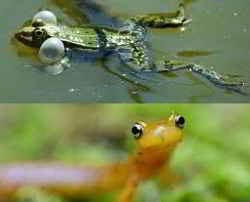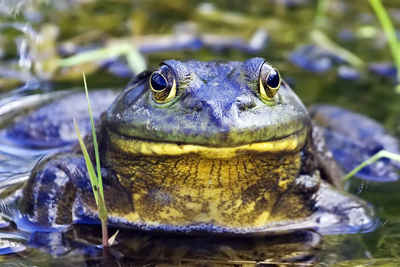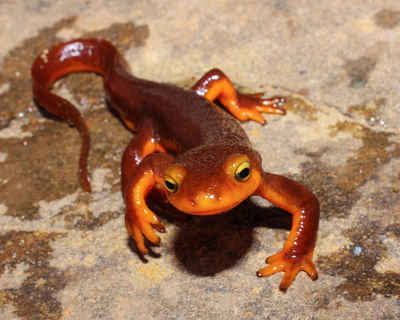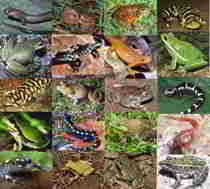
State Amphibians
US Official State Amphibians Designations
Official Amphibians: Frogs, Toads, Salamanders, & Newts
State amphibians are designated by tradition or the respective state legislatures. New Hampshire has the honor of being the first state to designate an official state amphibian. It did so in 1985. To date, at least seventeen other states have followed New Hampshire's lead.
Amphibian evolution: You wouldn't know it from the small (and rapidly dwindling) population of frogs, toads and salamanders alive today, but for tens of millions of years spanning the late Carboniferous and early Permian periods amphibians were the dominant land animals on earth. Some achieved crocodile-like sizes (up to 15 feet long, which may not seem so big today but was positively huge 300 million years ago) and terrorized smaller animals as the "apex predators" of their swampy ecosystems.
Amphibians
These little animals are generally tied to water, especially to reproduce, and have slimy skin they can breathe through.
 Frogs & Toads:
Frogs & Toads:
Belonging to the order Anura, from the Greek meaning "no tail." Characterized by their long folded hind legs, webbed digits and protruding eyes. Tied to water for reproduction. Used strictly, the term may be limited to any member of the family Ranidae (true frogs), but more broadly the name frog is often used to distinguish the smooth-skinned, leaping anurans from squat, warty, hopping ones, which are called toads. Frogs are also typically longer than toads. Also, frogs have smooth, slimy skin;toads have dry, bumpy skin. The bumps, however, are not warts There are roughly 5,400 species of living anurans.
-
 Salamanders &
Newts:
Salamanders &
Newts:
Amphibians of the order Urodelia. Characterized by slender, moist and scale-less bodies, small limbs and long tails . Primarily tied to water or damp areas. Newts are a more primitive form of salamanders, but newts have dry, bumpy skin. Salamanders have smooth, wet skin like a frog’s. Newts spend most of their time on land. Salamanders can live on land or in the water, depending on the species.
Amphibians are more important than you might think. No, not as the sources of warts and princes, but as a barometer of the health of the environments we all share. At an international conference in 1989, scientists all over the world became alarmed at what appeared to be dramatic declines in some amphibian populations. Then, in 1995, a group of school children in Minnesota were the first to notice an alarming rate of malformed limbs in some frog populations. Because amphibians use wetland habitats during at least part of their life cycle and because they have permeable skin, ecologists believe that declines in amphibian populations and malformations may serve as early warning indicators of broader changes in ecosystems.
Reptiles and amphibians have figured prominently in the folklore and superstitions of almost every culture and civilization throughout history. The secretive habits, unusual shapes, and, in some cases, dangerous attributes of these animals have always given them exalted status in the realms of the imagination. According to fossil evidence, reptiles and amphibians have each been the dominant land vertebrates during various periods in the earth's history. Salamander-like amphibians as large as crocodiles once cruised through primeval swamps, and were later supplanted by the scaly-skinned, desiccation-resistant reptiles whose tracks can still be seen in the sedimentary rock strata of the Connecticut River valley. Modern reptiles and amphibians, drastically reduced in size and status from former times, are today in need of public compassion, protection and understanding to survive in an increasingly human-altered environment.
Historically, the scientific community regarded reptiles and amphibians as lesser members of wildlife communities; consequently, comparatively little research was conducted on their ecological roles and requirements until relatively recently. Today they are recognized as important and dynamic elements of biodiversity with essential functions in food webs, soil and wetland ecology, and the energy recycling systems of forests. Research indicates that these two faunal groups, especially the amphibians, may be among the best indicators of environmental quality. Several species have also made important contributions to medical science, providing the basis of many life-saving drugs. As further light is shed on the functioning of their immune systems, skin secretions, venoms, and other physiological and biochemical processes, it seems certain that reptiles and amphibians will yield many other useful discoveries
Find images, descriptions, taxonomic hierarchy, and a history of the State Amphibians. Lists their basic characteristics, including adoption date, picture, state code, description, characteristics, range and habitat, habits, life cycle, status, and taxonomic hierarchy.





